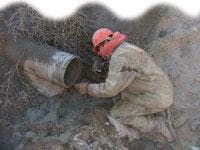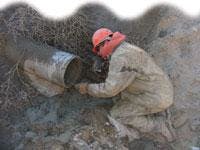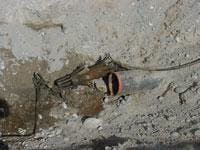By Deb Dunn & Geoff Tyree
Twenty-eight miles of aging cast iron and steel waterlines in one of the world's largest environmental cleanup projects will be replaced or refurbished using the mortar lining technique to prevent further contamination of groundwater from radioactive and chemical wastes still trapped in the soil.
The US Department of Energy's Hanford Site produced two-thirds of the plutonium used by the govern-ment for defense purposes, and generated the nation's largest volume of radioactive and chemical waste. The Hanford site covers 586 square miles in the arid southeast corner of the state of Washington.
Hanford was established as part of the World War II-era Manhattan Project, and plutonium production continued nearly until the end of the Cold War in the early 1990s. Cleanup of the site began in the 1980s and is expected to continue under the direction of the DOE until it is completed in 2035.
Fluor Hanford, Inc., the prime contractor to the US Department of Energy, is responsible for several major cleanup projects on the site, including the Groundwater Protection Programme. Fluor is also responsible for site infrastructure, ensuring that adequate water supplies are available for drinking and fire protection during cleanup and closure activities.
Groundwater protection is a major focus of the DOE and its contractors at the Hanford site in addition to cleaning up former nuclear materials produc-tion facilities. Wastes were routinely discharged into the soil during production years. Some of these contaminants have been moving through the groundwater toward the Columbia River that borders the site. Other contaminants remain trapped in the soil above the groundwater.
Efforts to stop or slow the migration of these contaminants and prevent further contamination of the groundwater have been underway for the past few years. One important action during production years. Some of these contaminants have been moving through the groundwater toward the Columbia River that borders the site. Other contaminants remain trapped in the soil above the groundwater.
Efforts to stop or slow the migration of these contaminants and prevent further contamination of the groundwater have been underway for the past few years. One important action includes stopping water or effluent discharges into the soil.
Fluor eliminated noncompliant and improperly-sized septic systems and improved management of storm water runoff. Attention is now being focused on leaks from aging waterlines to further protect groundwater.
Some of Hanford's waterlines run through or near contaminated soil sites. Deterioration of the pipes—due to age—leads to leaks that could drive contaminants from the soil deeper toward the groundwater.
Like many cities, the Hanford Site faces growing challenges due to aging infrastructure, which are intensified by radioactive and hazardous wastes at the site. Most of Hanford's waterlines are made of rust-prone cast iron or steel, part of a 50-year-old system designed to supply large production facilities. As these facilities shut down, the volume of water flowing through the pipelines greatly diminished. These low flow rates promoted rust and scale buildup, commonly called tuberculation, inside the pipes.
Internal pipe corrosion also resulted in sediment-laden, "rusty" water. As the number of customer complaints about palatability increased, facilities began using individual filtration systems to maintain water quality, adding to maintenance costs. Scale buildup within the pipes caused water pressure to decrease during periods of high flows, leading to further complaints by the Hanford Site Fire Department. The potential for more leaks in the aging pipes increased as pumps worked harder to boost water pressure. The DOE decided to stop this vicious cycle by replacing or refurbishing the piping .
Traditionally, degraded waterlines were replaced. Accelerated cleanup plans and funding constraints for infrastructure improvements have limited waterline replacement to pipes that are in the worst condition. Hanford's Water System Master Plan identified approximately 28 miles of pre-1960s water distribution piping that needs to be replaced or refurbished.
The mortar lining technique has been widely used in the region's agricultural industry, and it is gaining ground as a way to restore municipal drinking water system piping. Following a period of research and investigation, Fluor and the DOE selected mortar lining as an alternative to replacing deteriorating waterlines. The technique can be applied to most active ferrous metal water lines, even heavily tuberculated ones. It stops leaks and corrosion in steel or cast iron lines and maintains the system's ability to comply with drinking water standards.
The mortar-lining method restores pipelines in place by applying a proven formula of high-strength cement mortar as a liner that stops leaks and smoothes pipe interiors. Pipelines are excavated at access points every 500 to 700 feet. A remote video camera on a cable assembly is pulled through the empty section to determine the condition of the pipe interior. High-pressure water jets are used to break up the scale where scale buildup is severe. A variety of scrapers, attached to winches, are then pulled through the section to clean the pipe. Rubber squeegees on a piston assembly are pulled through the pipelines to remove any remaining water and to complete the cleaning process.
A formula of sand, cement and water is prepared in a nearby hopper and pumped through a hose to the lining head. A high-speed motor in the lining head applies the mortar to the pipe interior using centrifugal force. The pumping rate and the pulling rate of the lining assembly control the thickness of the lining. A mortar thickness of approximately 3/16 of an inch is commonly used. A stainless steel drag trowel follows the lining assembly to produce a dense, smooth finish.
The Hanford Site water distribution lines range from four to 42 inches in diameter. For pipes up to 24 inches in diameter, the drag trowel is pulled behind the lining assembly in a fixed position. In larger-diameter pipes, multiple trowels, designed to rotate, are used to achieve the desired smooth surface.
When the mortar is dry, the line is again checked with the camera, flushed, sanitized, and returned to reliable long-term service. This process can extend the useful design life of the pipeline by as much as 50 years, depending on the condition of the existing pipeline.
Fluor Hanford performed field testing between September 2002 and January 2003 following refurbishment of an 1,800-feet-long section of eight-inch cast iron potable water line by area contractors Morrison Construction Services and Columbia Pumping & Construction, Inc. Results indicated that at the same residual pressure reading of 20 psi, flow rates nearly tripled, from 460 gallons per minute (gpm) to 1,403 gpm.
Successful field testing led to the development of a detailed plan to apply mortar lining to 28 miles of Hanford's most degraded waterlines. Mortar-lining work is now underway on the first two miles of the site's most leaky and rusty waterlines. Current plans call for mortar-lining efforts to continue through the next 10 years.
"Mortar-lining is certainly proving to be cost effective," said Steve Wisness, DOE Richland Operations Office. "Twice as much waterline can be rehabilitated with mortar-lining as could be replaced with available funds. The DOE expects to avoid costs of more than US$ 19 million over the 10-year life of the project.
The lining technique offers several other benefits in addition to improving the taste of water and slightly reducing the amount of chlorination required. Lining the water pipelines eliminates the potential for leaks that could transport existing contaminants into the soil.
"Restoration of these lines protects the groundwater, which helps Fluor achieve the Department of Energy's risk reduction goals for Hanford—at the lowest possible cost to the taxpayers," said Brian Harmon, Fluor Hanford project manager.
Pumps use less electricity, because they operate more efficiently after the technique restores a smooth pipeline interior. Excavations at intervals minimises the disturbance to the environment, and protects Hanford employees by limiting exposure to potentially contaminated soil.
"Hanford Site employees and the Fire Department immediately recognised the value of this simple process," said Harmon. Removal of rust and scale removes the potential for small chunks of sediment to clog fire protection piping and sprinkler heads during high-velocity fire flows.
"We have to have ample water supplies for our fire hydrants and our fire trucks," said Hanford Fire Chief Don Good. "Recently, with this new project called mortar-lining, our capabilities have improved greatly. By relining these old pipes, we have seen tremendous increases in the amount of water and the pressures that are available to us through our fire hydrants."
In July 2003, the US Environmental Protection Agency (Region 10) awarded the Hanford Site Mortar-Lining Project and the Department of Energy's Richland Operations Office as one of several winners in the first annual Champions for Environmental Leadership and Green Government Innovation program. The program acknowledges individuals and groups of federal agencies outside of the EPA for demonstrating leadership in improving the environment and protecting natural resources in the Pacific Northwest region.
Authors' NoteCommunications Specialist Deb Dunn and Media Relations Manager Geoff Tyree of Fluor Hanford Communications are based in Richland, Washington, USA. Brian Harmon, the Fluor Hanford project manager, contributed to this article.






